Case Study: C. difficile Infection Impact on Activities of Living
VerifiedAdded on 2023/05/27
|26
|3876
|335
Case Study
AI Summary
This case study analyzes the case of Mr. Jones, an octogenarian admitted with a C. difficile infection (CDI). It explores the impact of CDI on the patient's activities of living (AoL), specifically eating and drinking, personal cleansing and grooming, and elimination. The report details the alterations in AoLs due to the infection, including dietary changes, hygiene challenges, and elimination difficulties. It outlines comprehensive nursing care plans to address these issues, focusing on dietary modifications, infection control measures, and management of elimination needs. The assessment of nursing care impacts utilizes the Barthel Index to measure functional independence. The nursing care plan includes goals, interventions, and evaluation strategies to improve the patient's condition, address potential complications like pressure ulcers, and promote overall well-being. The study emphasizes the importance of proactive nursing interventions to improve patient outcomes and prevent the spread of infection. The plan includes interventions for appetite improvement, pressure ulcer prevention, and other critical aspects of care to enhance the patient's quality of life.
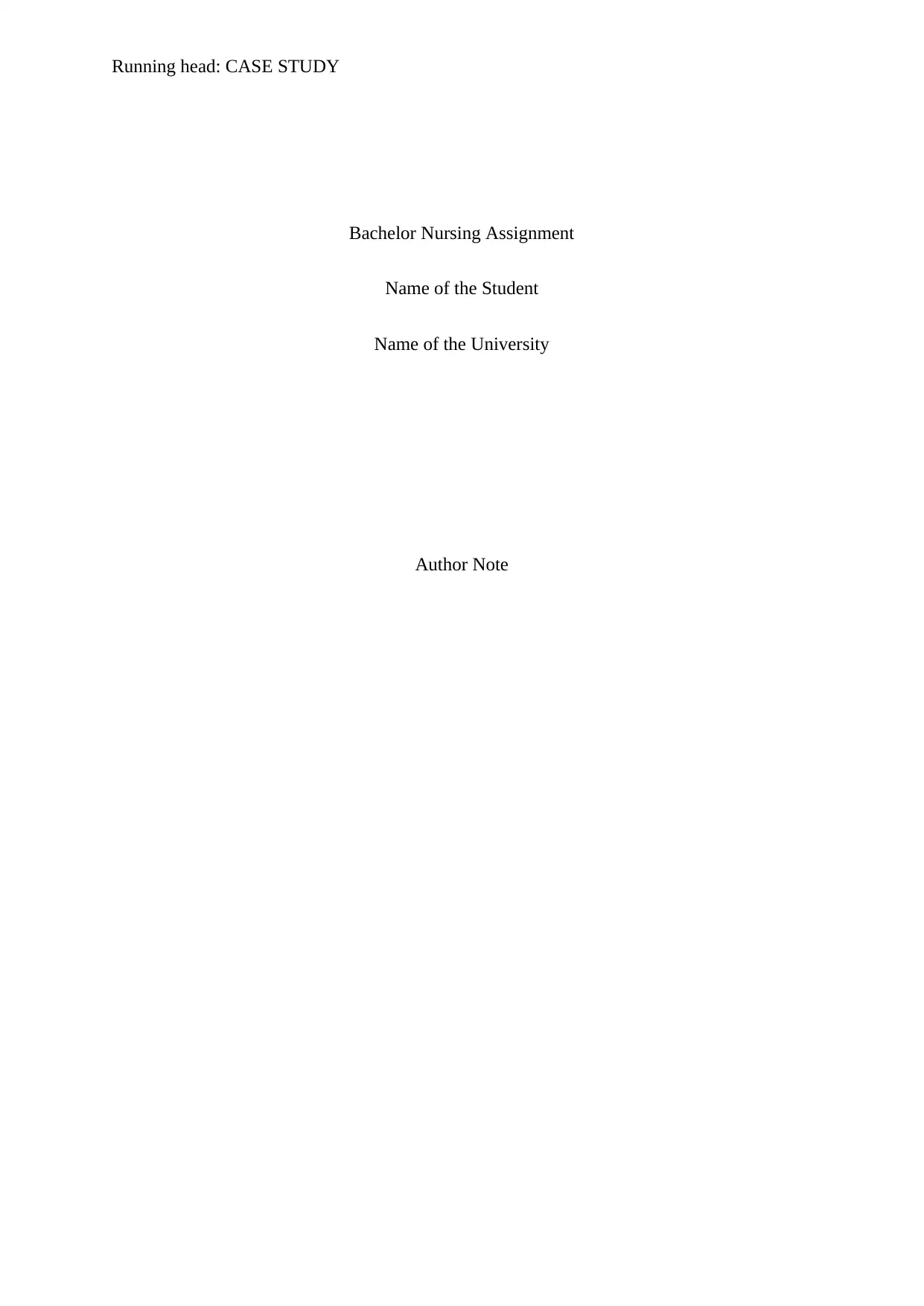
Running head: CASE STUDY
Bachelor Nursing Assignment
Name of the Student
Name of the University
Author Note
Bachelor Nursing Assignment
Name of the Student
Name of the University
Author Note
Paraphrase This Document
Need a fresh take? Get an instant paraphrase of this document with our AI Paraphraser
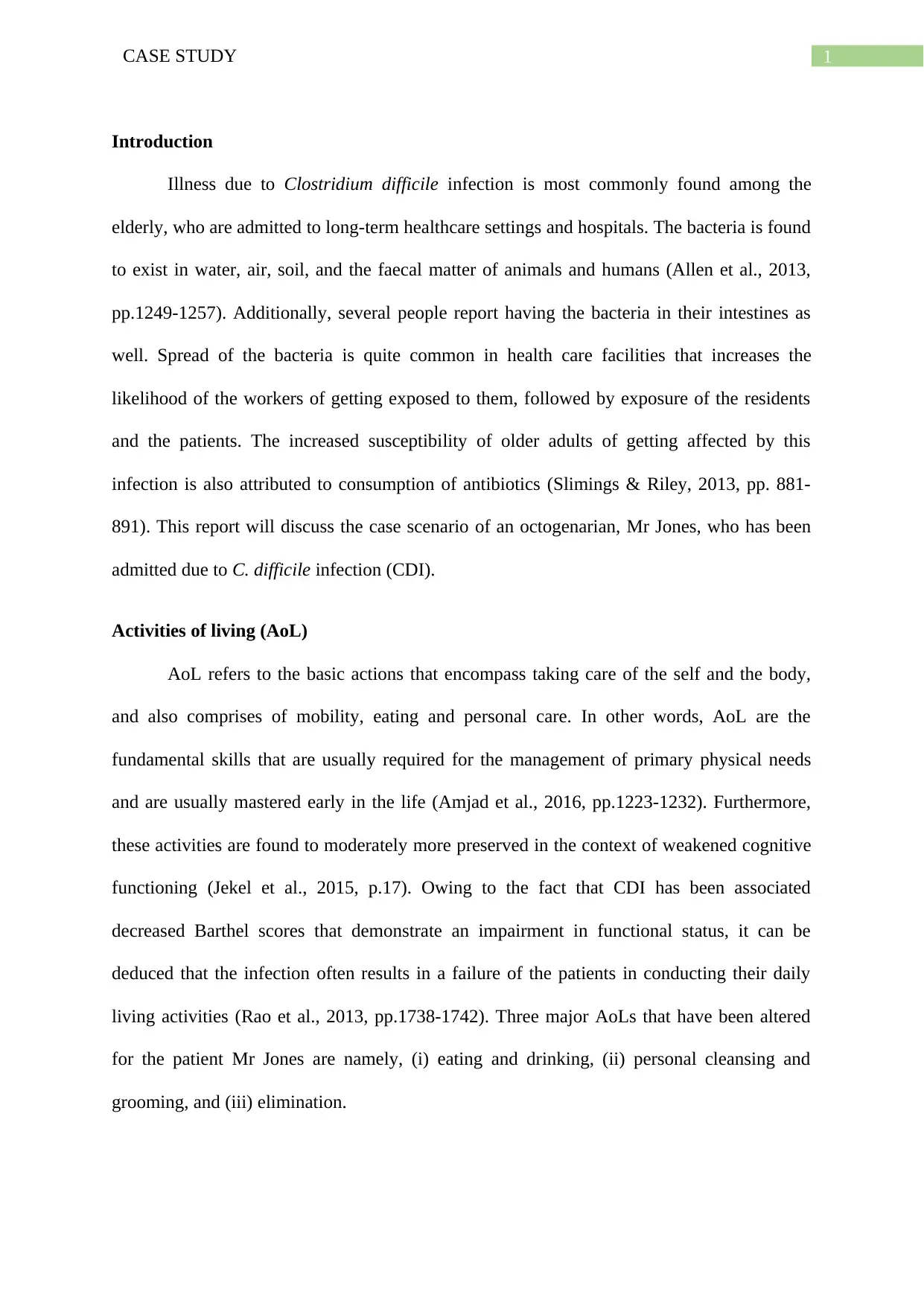
1CASE STUDY
Introduction
Illness due to Clostridium difficile infection is most commonly found among the
elderly, who are admitted to long-term healthcare settings and hospitals. The bacteria is found
to exist in water, air, soil, and the faecal matter of animals and humans (Allen et al., 2013,
pp.1249-1257). Additionally, several people report having the bacteria in their intestines as
well. Spread of the bacteria is quite common in health care facilities that increases the
likelihood of the workers of getting exposed to them, followed by exposure of the residents
and the patients. The increased susceptibility of older adults of getting affected by this
infection is also attributed to consumption of antibiotics (Slimings & Riley, 2013, pp. 881-
891). This report will discuss the case scenario of an octogenarian, Mr Jones, who has been
admitted due to C. difficile infection (CDI).
Activities of living (AoL)
AoL refers to the basic actions that encompass taking care of the self and the body,
and also comprises of mobility, eating and personal care. In other words, AoL are the
fundamental skills that are usually required for the management of primary physical needs
and are usually mastered early in the life (Amjad et al., 2016, pp.1223-1232). Furthermore,
these activities are found to moderately more preserved in the context of weakened cognitive
functioning (Jekel et al., 2015, p.17). Owing to the fact that CDI has been associated
decreased Barthel scores that demonstrate an impairment in functional status, it can be
deduced that the infection often results in a failure of the patients in conducting their daily
living activities (Rao et al., 2013, pp.1738-1742). Three major AoLs that have been altered
for the patient Mr Jones are namely, (i) eating and drinking, (ii) personal cleansing and
grooming, and (iii) elimination.
Introduction
Illness due to Clostridium difficile infection is most commonly found among the
elderly, who are admitted to long-term healthcare settings and hospitals. The bacteria is found
to exist in water, air, soil, and the faecal matter of animals and humans (Allen et al., 2013,
pp.1249-1257). Additionally, several people report having the bacteria in their intestines as
well. Spread of the bacteria is quite common in health care facilities that increases the
likelihood of the workers of getting exposed to them, followed by exposure of the residents
and the patients. The increased susceptibility of older adults of getting affected by this
infection is also attributed to consumption of antibiotics (Slimings & Riley, 2013, pp. 881-
891). This report will discuss the case scenario of an octogenarian, Mr Jones, who has been
admitted due to C. difficile infection (CDI).
Activities of living (AoL)
AoL refers to the basic actions that encompass taking care of the self and the body,
and also comprises of mobility, eating and personal care. In other words, AoL are the
fundamental skills that are usually required for the management of primary physical needs
and are usually mastered early in the life (Amjad et al., 2016, pp.1223-1232). Furthermore,
these activities are found to moderately more preserved in the context of weakened cognitive
functioning (Jekel et al., 2015, p.17). Owing to the fact that CDI has been associated
decreased Barthel scores that demonstrate an impairment in functional status, it can be
deduced that the infection often results in a failure of the patients in conducting their daily
living activities (Rao et al., 2013, pp.1738-1742). Three major AoLs that have been altered
for the patient Mr Jones are namely, (i) eating and drinking, (ii) personal cleansing and
grooming, and (iii) elimination.
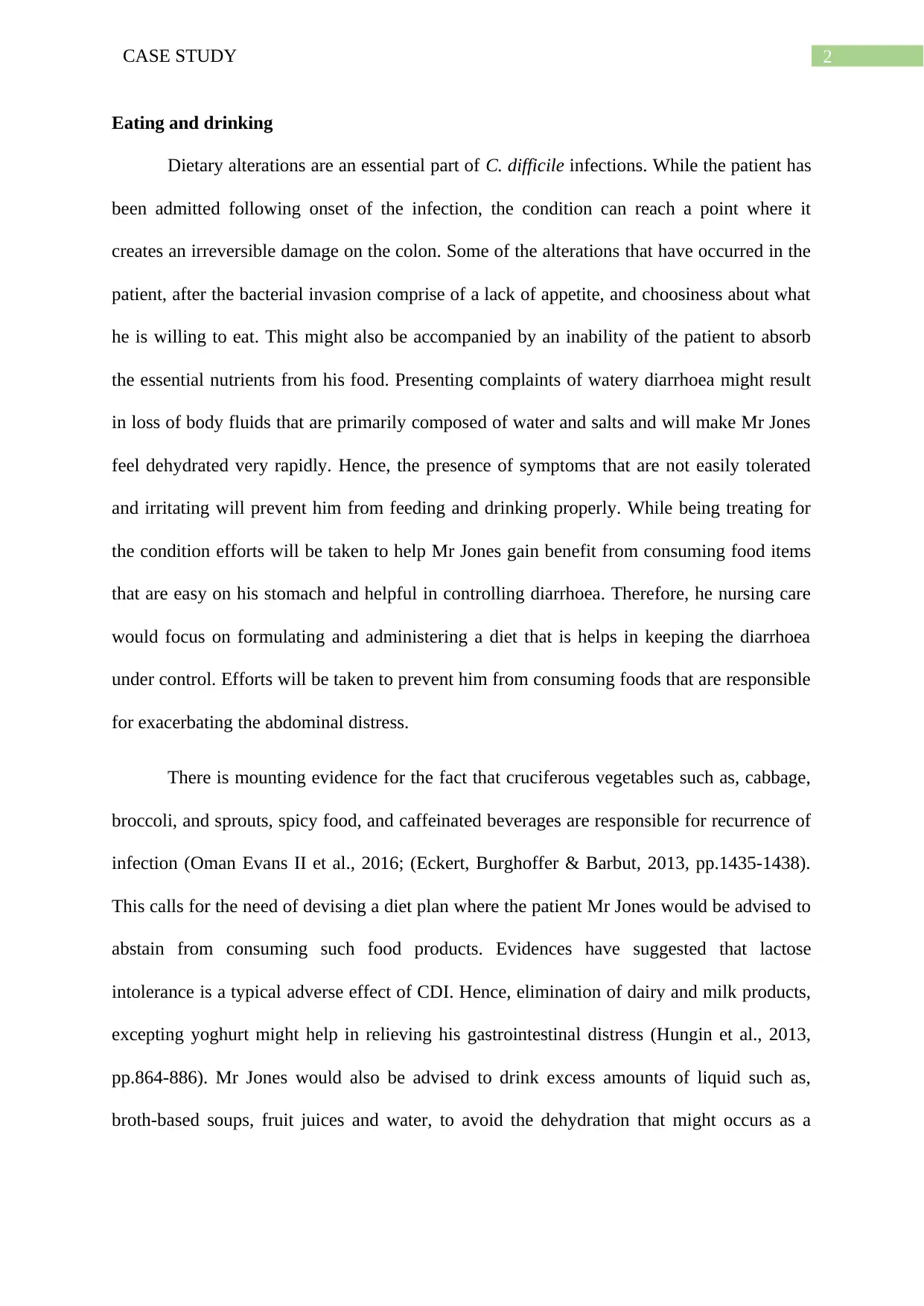
2CASE STUDY
Eating and drinking
Dietary alterations are an essential part of C. difficile infections. While the patient has
been admitted following onset of the infection, the condition can reach a point where it
creates an irreversible damage on the colon. Some of the alterations that have occurred in the
patient, after the bacterial invasion comprise of a lack of appetite, and choosiness about what
he is willing to eat. This might also be accompanied by an inability of the patient to absorb
the essential nutrients from his food. Presenting complaints of watery diarrhoea might result
in loss of body fluids that are primarily composed of water and salts and will make Mr Jones
feel dehydrated very rapidly. Hence, the presence of symptoms that are not easily tolerated
and irritating will prevent him from feeding and drinking properly. While being treating for
the condition efforts will be taken to help Mr Jones gain benefit from consuming food items
that are easy on his stomach and helpful in controlling diarrhoea. Therefore, he nursing care
would focus on formulating and administering a diet that is helps in keeping the diarrhoea
under control. Efforts will be taken to prevent him from consuming foods that are responsible
for exacerbating the abdominal distress.
There is mounting evidence for the fact that cruciferous vegetables such as, cabbage,
broccoli, and sprouts, spicy food, and caffeinated beverages are responsible for recurrence of
infection (Oman Evans II et al., 2016; (Eckert, Burghoffer & Barbut, 2013, pp.1435-1438).
This calls for the need of devising a diet plan where the patient Mr Jones would be advised to
abstain from consuming such food products. Evidences have suggested that lactose
intolerance is a typical adverse effect of CDI. Hence, elimination of dairy and milk products,
excepting yoghurt might help in relieving his gastrointestinal distress (Hungin et al., 2013,
pp.864-886). Mr Jones would also be advised to drink excess amounts of liquid such as,
broth-based soups, fruit juices and water, to avoid the dehydration that might occurs as a
Eating and drinking
Dietary alterations are an essential part of C. difficile infections. While the patient has
been admitted following onset of the infection, the condition can reach a point where it
creates an irreversible damage on the colon. Some of the alterations that have occurred in the
patient, after the bacterial invasion comprise of a lack of appetite, and choosiness about what
he is willing to eat. This might also be accompanied by an inability of the patient to absorb
the essential nutrients from his food. Presenting complaints of watery diarrhoea might result
in loss of body fluids that are primarily composed of water and salts and will make Mr Jones
feel dehydrated very rapidly. Hence, the presence of symptoms that are not easily tolerated
and irritating will prevent him from feeding and drinking properly. While being treating for
the condition efforts will be taken to help Mr Jones gain benefit from consuming food items
that are easy on his stomach and helpful in controlling diarrhoea. Therefore, he nursing care
would focus on formulating and administering a diet that is helps in keeping the diarrhoea
under control. Efforts will be taken to prevent him from consuming foods that are responsible
for exacerbating the abdominal distress.
There is mounting evidence for the fact that cruciferous vegetables such as, cabbage,
broccoli, and sprouts, spicy food, and caffeinated beverages are responsible for recurrence of
infection (Oman Evans II et al., 2016; (Eckert, Burghoffer & Barbut, 2013, pp.1435-1438).
This calls for the need of devising a diet plan where the patient Mr Jones would be advised to
abstain from consuming such food products. Evidences have suggested that lactose
intolerance is a typical adverse effect of CDI. Hence, elimination of dairy and milk products,
excepting yoghurt might help in relieving his gastrointestinal distress (Hungin et al., 2013,
pp.864-886). Mr Jones would also be advised to drink excess amounts of liquid such as,
broth-based soups, fruit juices and water, to avoid the dehydration that might occurs as a
⊘ This is a preview!⊘
Do you want full access?
Subscribe today to unlock all pages.

Trusted by 1+ million students worldwide
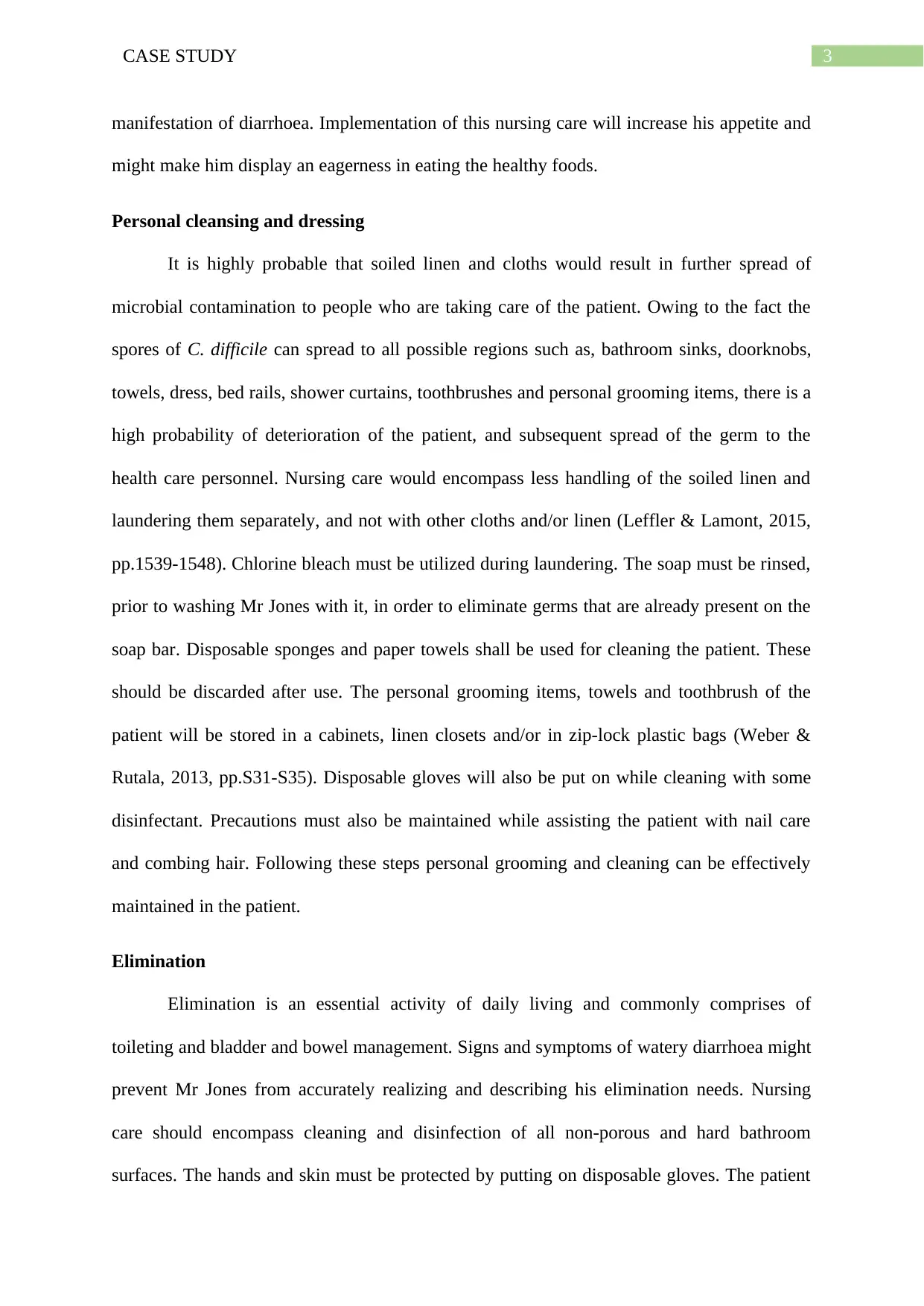
3CASE STUDY
manifestation of diarrhoea. Implementation of this nursing care will increase his appetite and
might make him display an eagerness in eating the healthy foods.
Personal cleansing and dressing
It is highly probable that soiled linen and cloths would result in further spread of
microbial contamination to people who are taking care of the patient. Owing to the fact the
spores of C. difficile can spread to all possible regions such as, bathroom sinks, doorknobs,
towels, dress, bed rails, shower curtains, toothbrushes and personal grooming items, there is a
high probability of deterioration of the patient, and subsequent spread of the germ to the
health care personnel. Nursing care would encompass less handling of the soiled linen and
laundering them separately, and not with other cloths and/or linen (Leffler & Lamont, 2015,
pp.1539-1548). Chlorine bleach must be utilized during laundering. The soap must be rinsed,
prior to washing Mr Jones with it, in order to eliminate germs that are already present on the
soap bar. Disposable sponges and paper towels shall be used for cleaning the patient. These
should be discarded after use. The personal grooming items, towels and toothbrush of the
patient will be stored in a cabinets, linen closets and/or in zip-lock plastic bags (Weber &
Rutala, 2013, pp.S31-S35). Disposable gloves will also be put on while cleaning with some
disinfectant. Precautions must also be maintained while assisting the patient with nail care
and combing hair. Following these steps personal grooming and cleaning can be effectively
maintained in the patient.
Elimination
Elimination is an essential activity of daily living and commonly comprises of
toileting and bladder and bowel management. Signs and symptoms of watery diarrhoea might
prevent Mr Jones from accurately realizing and describing his elimination needs. Nursing
care should encompass cleaning and disinfection of all non-porous and hard bathroom
surfaces. The hands and skin must be protected by putting on disposable gloves. The patient
manifestation of diarrhoea. Implementation of this nursing care will increase his appetite and
might make him display an eagerness in eating the healthy foods.
Personal cleansing and dressing
It is highly probable that soiled linen and cloths would result in further spread of
microbial contamination to people who are taking care of the patient. Owing to the fact the
spores of C. difficile can spread to all possible regions such as, bathroom sinks, doorknobs,
towels, dress, bed rails, shower curtains, toothbrushes and personal grooming items, there is a
high probability of deterioration of the patient, and subsequent spread of the germ to the
health care personnel. Nursing care would encompass less handling of the soiled linen and
laundering them separately, and not with other cloths and/or linen (Leffler & Lamont, 2015,
pp.1539-1548). Chlorine bleach must be utilized during laundering. The soap must be rinsed,
prior to washing Mr Jones with it, in order to eliminate germs that are already present on the
soap bar. Disposable sponges and paper towels shall be used for cleaning the patient. These
should be discarded after use. The personal grooming items, towels and toothbrush of the
patient will be stored in a cabinets, linen closets and/or in zip-lock plastic bags (Weber &
Rutala, 2013, pp.S31-S35). Disposable gloves will also be put on while cleaning with some
disinfectant. Precautions must also be maintained while assisting the patient with nail care
and combing hair. Following these steps personal grooming and cleaning can be effectively
maintained in the patient.
Elimination
Elimination is an essential activity of daily living and commonly comprises of
toileting and bladder and bowel management. Signs and symptoms of watery diarrhoea might
prevent Mr Jones from accurately realizing and describing his elimination needs. Nursing
care should encompass cleaning and disinfection of all non-porous and hard bathroom
surfaces. The hands and skin must be protected by putting on disposable gloves. The patient
Paraphrase This Document
Need a fresh take? Get an instant paraphrase of this document with our AI Paraphraser
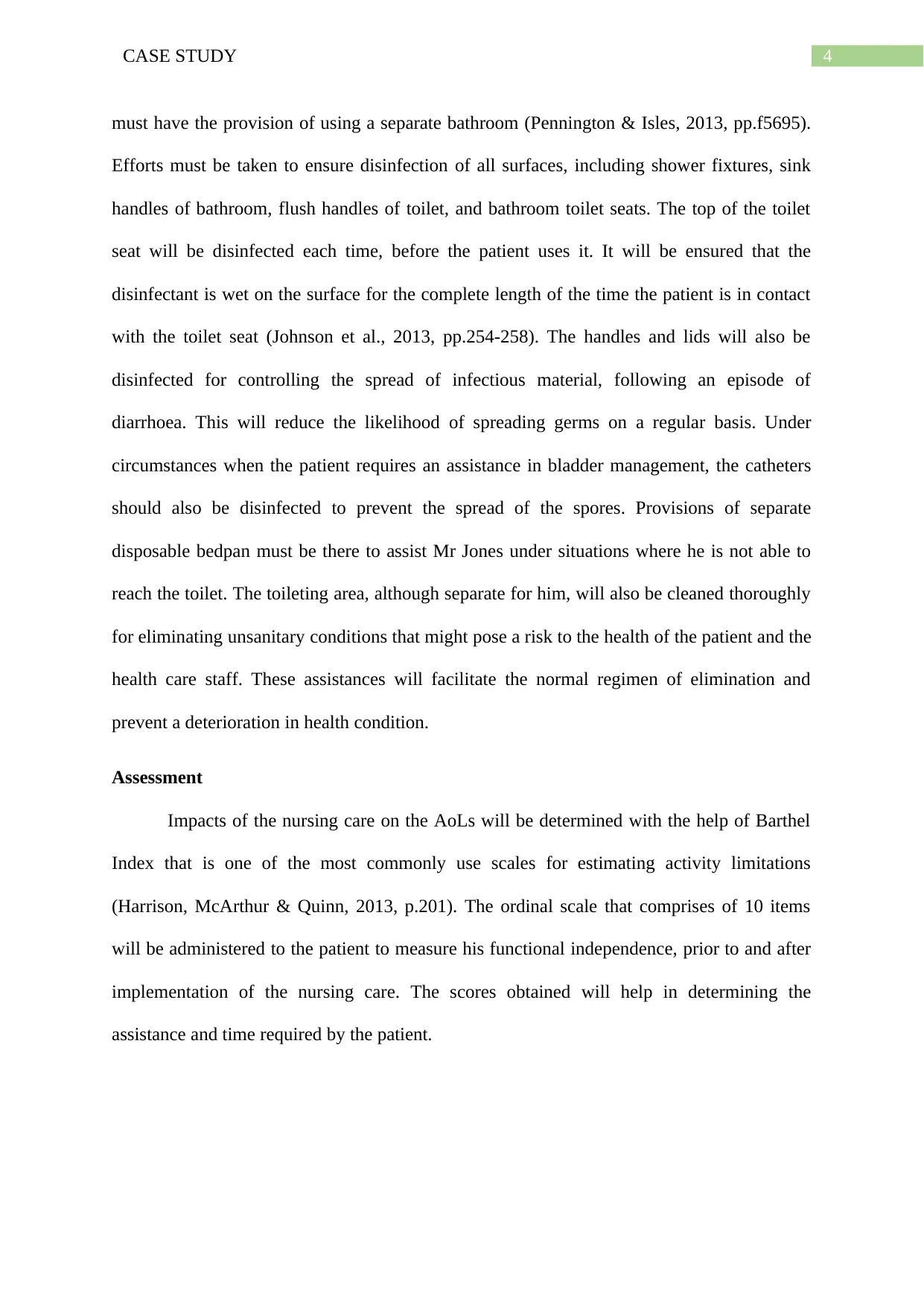
4CASE STUDY
must have the provision of using a separate bathroom (Pennington & Isles, 2013, pp.f5695).
Efforts must be taken to ensure disinfection of all surfaces, including shower fixtures, sink
handles of bathroom, flush handles of toilet, and bathroom toilet seats. The top of the toilet
seat will be disinfected each time, before the patient uses it. It will be ensured that the
disinfectant is wet on the surface for the complete length of the time the patient is in contact
with the toilet seat (Johnson et al., 2013, pp.254-258). The handles and lids will also be
disinfected for controlling the spread of infectious material, following an episode of
diarrhoea. This will reduce the likelihood of spreading germs on a regular basis. Under
circumstances when the patient requires an assistance in bladder management, the catheters
should also be disinfected to prevent the spread of the spores. Provisions of separate
disposable bedpan must be there to assist Mr Jones under situations where he is not able to
reach the toilet. The toileting area, although separate for him, will also be cleaned thoroughly
for eliminating unsanitary conditions that might pose a risk to the health of the patient and the
health care staff. These assistances will facilitate the normal regimen of elimination and
prevent a deterioration in health condition.
Assessment
Impacts of the nursing care on the AoLs will be determined with the help of Barthel
Index that is one of the most commonly use scales for estimating activity limitations
(Harrison, McArthur & Quinn, 2013, p.201). The ordinal scale that comprises of 10 items
will be administered to the patient to measure his functional independence, prior to and after
implementation of the nursing care. The scores obtained will help in determining the
assistance and time required by the patient.
must have the provision of using a separate bathroom (Pennington & Isles, 2013, pp.f5695).
Efforts must be taken to ensure disinfection of all surfaces, including shower fixtures, sink
handles of bathroom, flush handles of toilet, and bathroom toilet seats. The top of the toilet
seat will be disinfected each time, before the patient uses it. It will be ensured that the
disinfectant is wet on the surface for the complete length of the time the patient is in contact
with the toilet seat (Johnson et al., 2013, pp.254-258). The handles and lids will also be
disinfected for controlling the spread of infectious material, following an episode of
diarrhoea. This will reduce the likelihood of spreading germs on a regular basis. Under
circumstances when the patient requires an assistance in bladder management, the catheters
should also be disinfected to prevent the spread of the spores. Provisions of separate
disposable bedpan must be there to assist Mr Jones under situations where he is not able to
reach the toilet. The toileting area, although separate for him, will also be cleaned thoroughly
for eliminating unsanitary conditions that might pose a risk to the health of the patient and the
health care staff. These assistances will facilitate the normal regimen of elimination and
prevent a deterioration in health condition.
Assessment
Impacts of the nursing care on the AoLs will be determined with the help of Barthel
Index that is one of the most commonly use scales for estimating activity limitations
(Harrison, McArthur & Quinn, 2013, p.201). The ordinal scale that comprises of 10 items
will be administered to the patient to measure his functional independence, prior to and after
implementation of the nursing care. The scores obtained will help in determining the
assistance and time required by the patient.
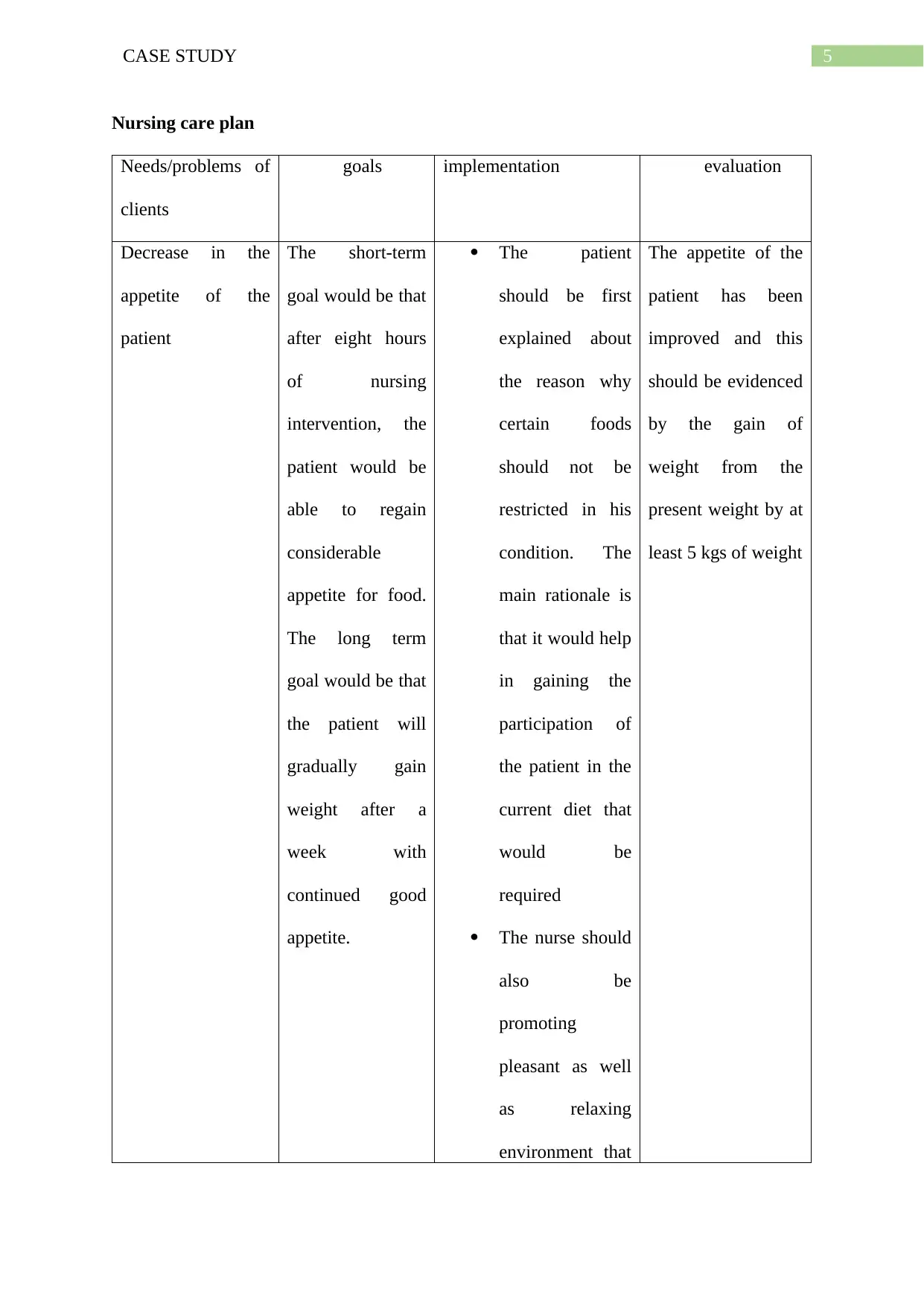
5CASE STUDY
Nursing care plan
Needs/problems of
clients
goals implementation evaluation
Decrease in the
appetite of the
patient
The short-term
goal would be that
after eight hours
of nursing
intervention, the
patient would be
able to regain
considerable
appetite for food.
The long term
goal would be that
the patient will
gradually gain
weight after a
week with
continued good
appetite.
The patient
should be first
explained about
the reason why
certain foods
should not be
restricted in his
condition. The
main rationale is
that it would help
in gaining the
participation of
the patient in the
current diet that
would be
required
The nurse should
also be
promoting
pleasant as well
as relaxing
environment that
The appetite of the
patient has been
improved and this
should be evidenced
by the gain of
weight from the
present weight by at
least 5 kgs of weight
Nursing care plan
Needs/problems of
clients
goals implementation evaluation
Decrease in the
appetite of the
patient
The short-term
goal would be that
after eight hours
of nursing
intervention, the
patient would be
able to regain
considerable
appetite for food.
The long term
goal would be that
the patient will
gradually gain
weight after a
week with
continued good
appetite.
The patient
should be first
explained about
the reason why
certain foods
should not be
restricted in his
condition. The
main rationale is
that it would help
in gaining the
participation of
the patient in the
current diet that
would be
required
The nurse should
also be
promoting
pleasant as well
as relaxing
environment that
The appetite of the
patient has been
improved and this
should be evidenced
by the gain of
weight from the
present weight by at
least 5 kgs of weight
⊘ This is a preview!⊘
Do you want full access?
Subscribe today to unlock all pages.

Trusted by 1+ million students worldwide
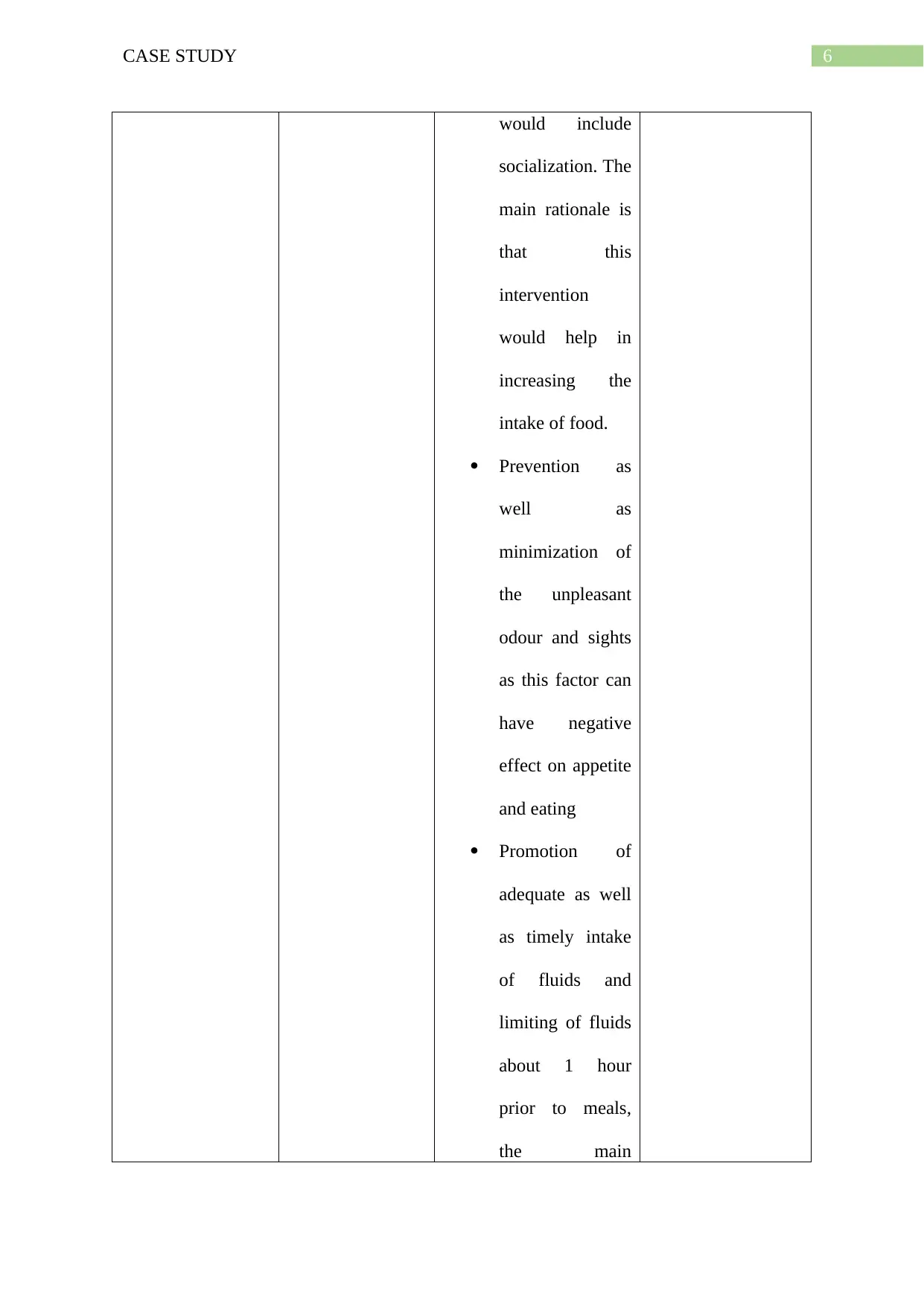
6CASE STUDY
would include
socialization. The
main rationale is
that this
intervention
would help in
increasing the
intake of food.
Prevention as
well as
minimization of
the unpleasant
odour and sights
as this factor can
have negative
effect on appetite
and eating
Promotion of
adequate as well
as timely intake
of fluids and
limiting of fluids
about 1 hour
prior to meals,
the main
would include
socialization. The
main rationale is
that this
intervention
would help in
increasing the
intake of food.
Prevention as
well as
minimization of
the unpleasant
odour and sights
as this factor can
have negative
effect on appetite
and eating
Promotion of
adequate as well
as timely intake
of fluids and
limiting of fluids
about 1 hour
prior to meals,
the main
Paraphrase This Document
Need a fresh take? Get an instant paraphrase of this document with our AI Paraphraser
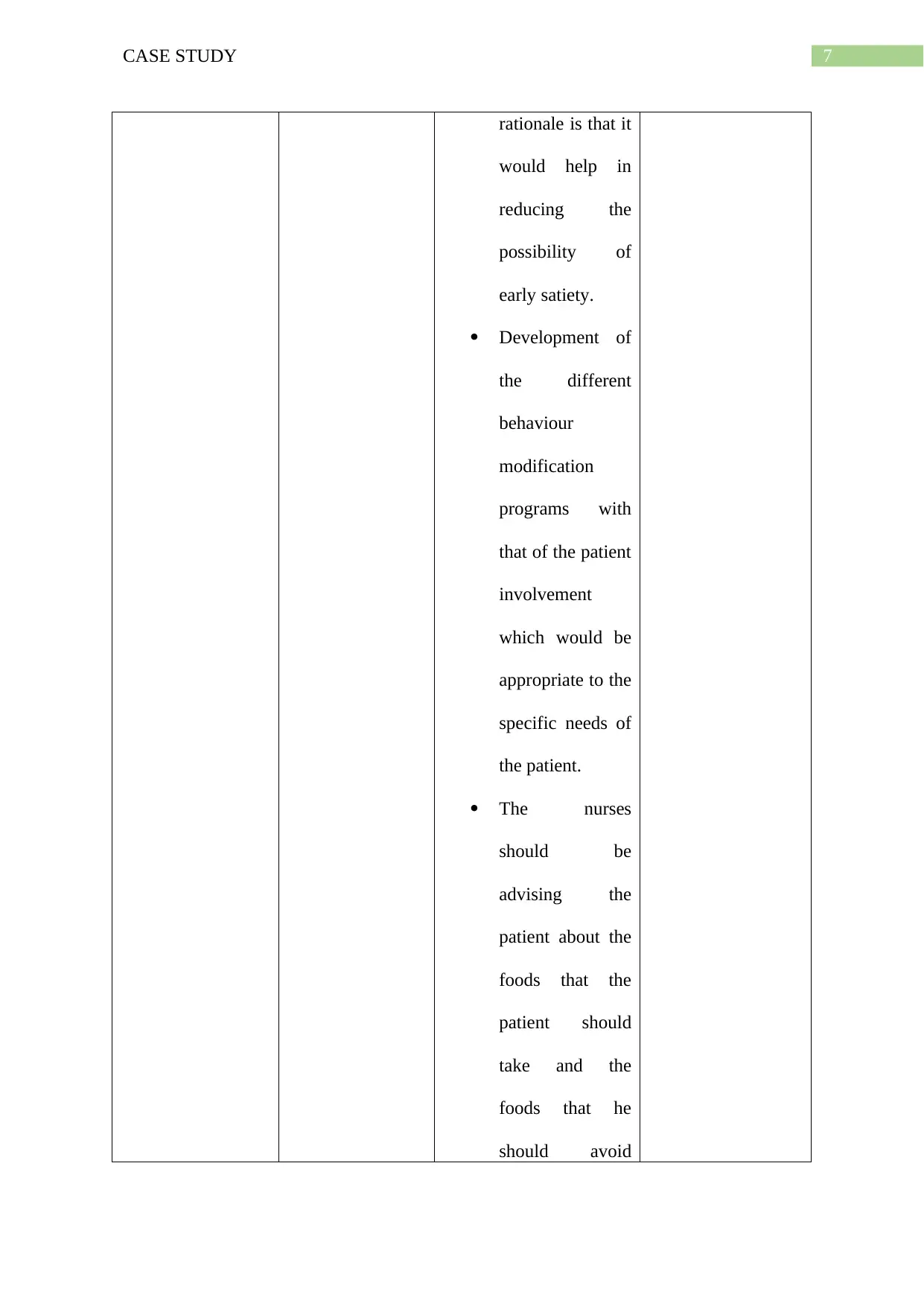
7CASE STUDY
rationale is that it
would help in
reducing the
possibility of
early satiety.
Development of
the different
behaviour
modification
programs with
that of the patient
involvement
which would be
appropriate to the
specific needs of
the patient.
The nurses
should be
advising the
patient about the
foods that the
patient should
take and the
foods that he
should avoid
rationale is that it
would help in
reducing the
possibility of
early satiety.
Development of
the different
behaviour
modification
programs with
that of the patient
involvement
which would be
appropriate to the
specific needs of
the patient.
The nurses
should be
advising the
patient about the
foods that the
patient should
take and the
foods that he
should avoid
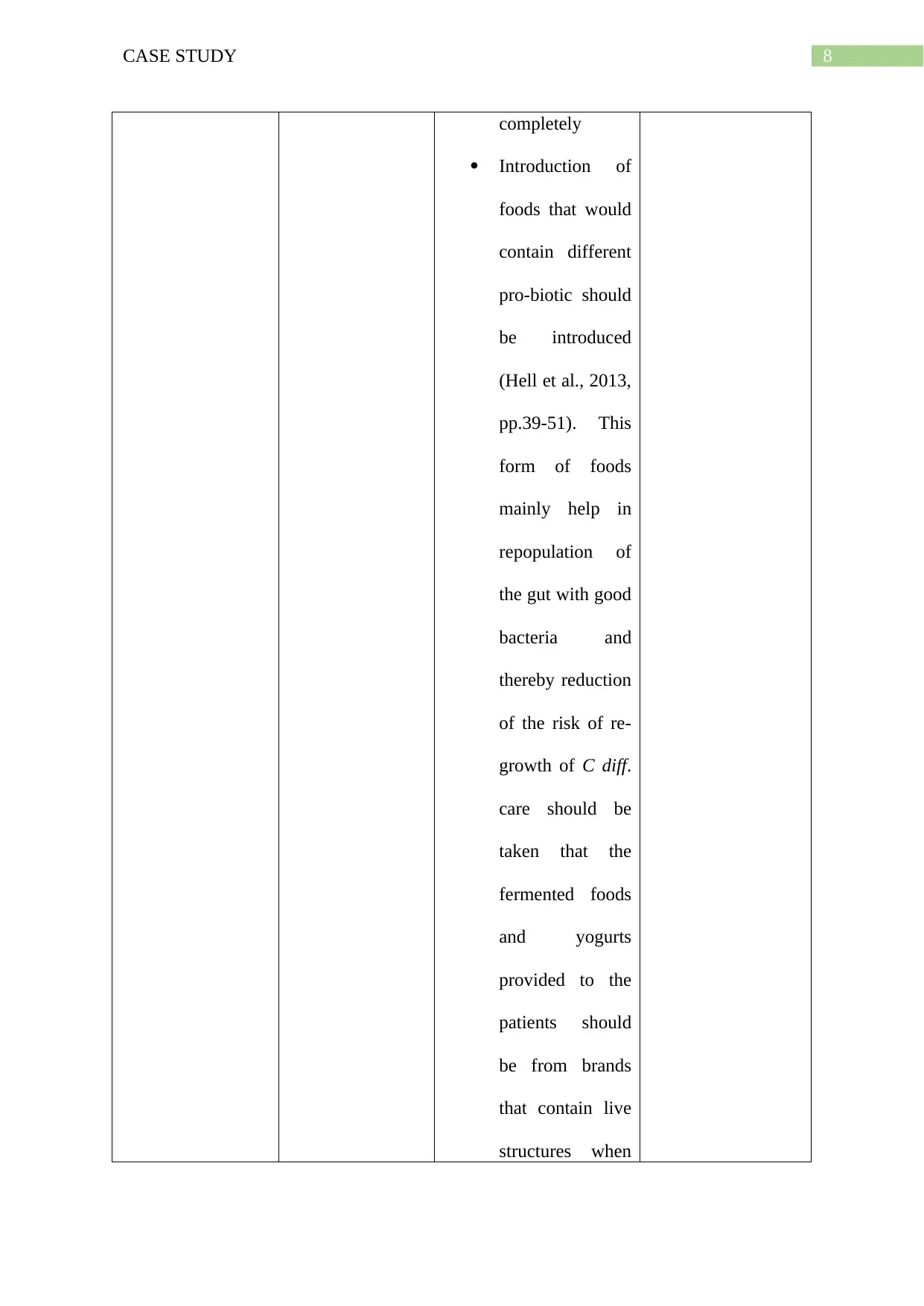
8CASE STUDY
completely
Introduction of
foods that would
contain different
pro-biotic should
be introduced
(Hell et al., 2013,
pp.39-51). This
form of foods
mainly help in
repopulation of
the gut with good
bacteria and
thereby reduction
of the risk of re-
growth of C diff.
care should be
taken that the
fermented foods
and yogurts
provided to the
patients should
be from brands
that contain live
structures when
completely
Introduction of
foods that would
contain different
pro-biotic should
be introduced
(Hell et al., 2013,
pp.39-51). This
form of foods
mainly help in
repopulation of
the gut with good
bacteria and
thereby reduction
of the risk of re-
growth of C diff.
care should be
taken that the
fermented foods
and yogurts
provided to the
patients should
be from brands
that contain live
structures when
⊘ This is a preview!⊘
Do you want full access?
Subscribe today to unlock all pages.

Trusted by 1+ million students worldwide
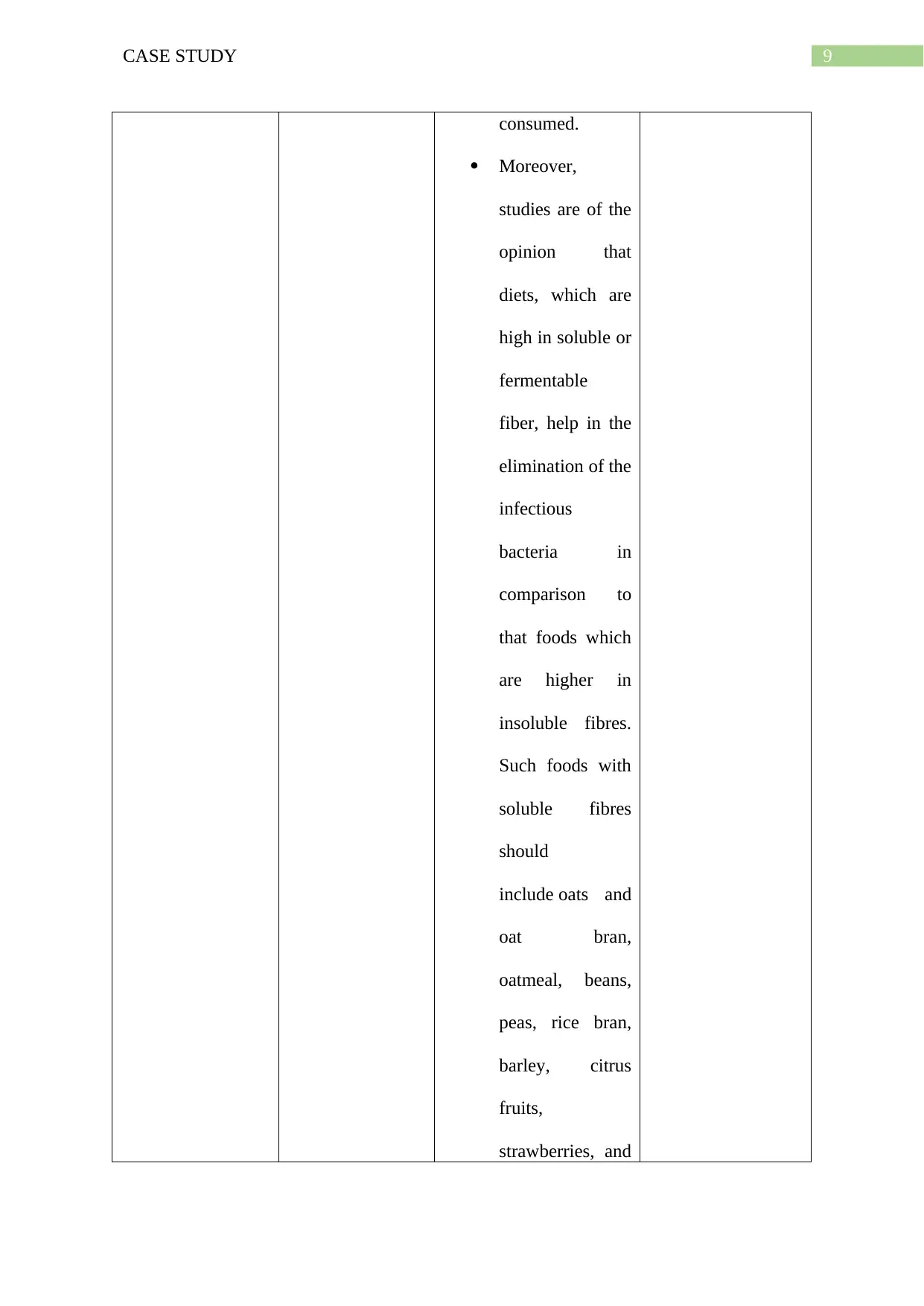
9CASE STUDY
consumed.
Moreover,
studies are of the
opinion that
diets, which are
high in soluble or
fermentable
fiber, help in the
elimination of the
infectious
bacteria in
comparison to
that foods which
are higher in
insoluble fibres.
Such foods with
soluble fibres
should
include oats and
oat bran,
oatmeal, beans,
peas, rice bran,
barley, citrus
fruits,
strawberries, and
consumed.
Moreover,
studies are of the
opinion that
diets, which are
high in soluble or
fermentable
fiber, help in the
elimination of the
infectious
bacteria in
comparison to
that foods which
are higher in
insoluble fibres.
Such foods with
soluble fibres
should
include oats and
oat bran,
oatmeal, beans,
peas, rice bran,
barley, citrus
fruits,
strawberries, and
Paraphrase This Document
Need a fresh take? Get an instant paraphrase of this document with our AI Paraphraser
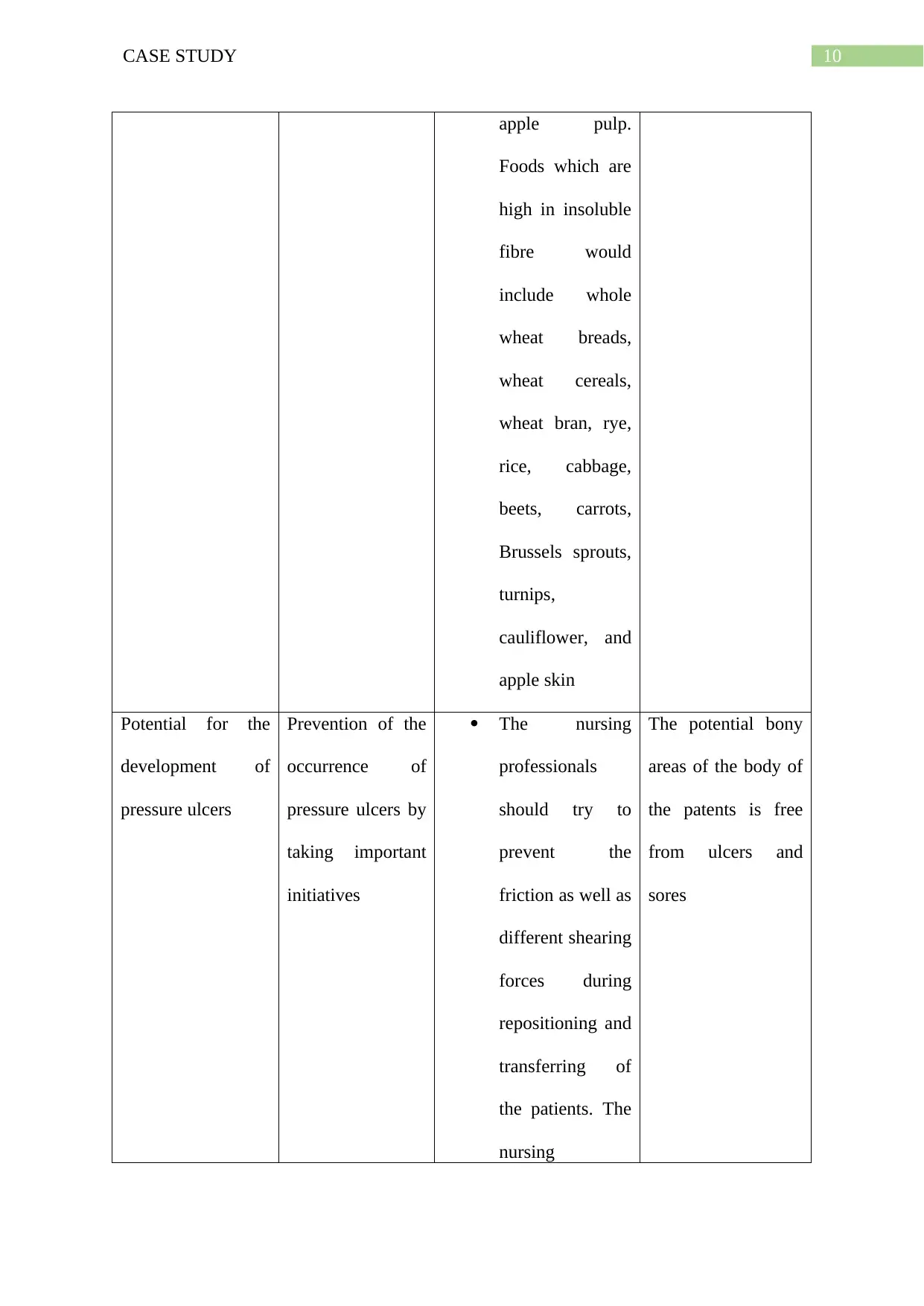
10CASE STUDY
apple pulp.
Foods which are
high in insoluble
fibre would
include whole
wheat breads,
wheat cereals,
wheat bran, rye,
rice, cabbage,
beets, carrots,
Brussels sprouts,
turnips,
cauliflower, and
apple skin
Potential for the
development of
pressure ulcers
Prevention of the
occurrence of
pressure ulcers by
taking important
initiatives
The nursing
professionals
should try to
prevent the
friction as well as
different shearing
forces during
repositioning and
transferring of
the patients. The
nursing
The potential bony
areas of the body of
the patents is free
from ulcers and
sores
apple pulp.
Foods which are
high in insoluble
fibre would
include whole
wheat breads,
wheat cereals,
wheat bran, rye,
rice, cabbage,
beets, carrots,
Brussels sprouts,
turnips,
cauliflower, and
apple skin
Potential for the
development of
pressure ulcers
Prevention of the
occurrence of
pressure ulcers by
taking important
initiatives
The nursing
professionals
should try to
prevent the
friction as well as
different shearing
forces during
repositioning and
transferring of
the patients. The
nursing
The potential bony
areas of the body of
the patents is free
from ulcers and
sores
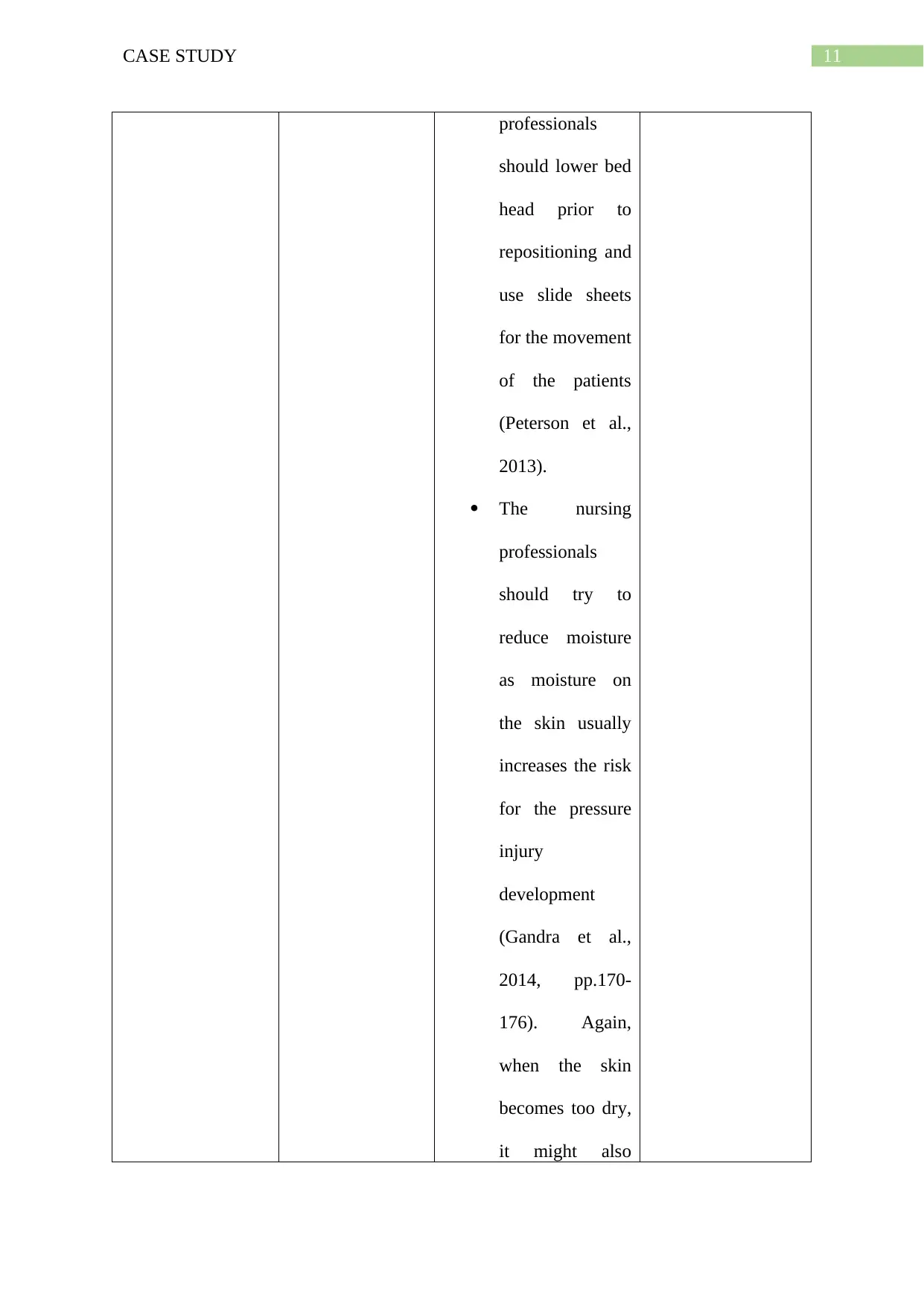
11CASE STUDY
professionals
should lower bed
head prior to
repositioning and
use slide sheets
for the movement
of the patients
(Peterson et al.,
2013).
The nursing
professionals
should try to
reduce moisture
as moisture on
the skin usually
increases the risk
for the pressure
injury
development
(Gandra et al.,
2014, pp.170-
176). Again,
when the skin
becomes too dry,
it might also
professionals
should lower bed
head prior to
repositioning and
use slide sheets
for the movement
of the patients
(Peterson et al.,
2013).
The nursing
professionals
should try to
reduce moisture
as moisture on
the skin usually
increases the risk
for the pressure
injury
development
(Gandra et al.,
2014, pp.170-
176). Again,
when the skin
becomes too dry,
it might also
⊘ This is a preview!⊘
Do you want full access?
Subscribe today to unlock all pages.

Trusted by 1+ million students worldwide
1 out of 26
Related Documents
Your All-in-One AI-Powered Toolkit for Academic Success.
+13062052269
info@desklib.com
Available 24*7 on WhatsApp / Email
![[object Object]](/_next/static/media/star-bottom.7253800d.svg)
Unlock your academic potential
Copyright © 2020–2025 A2Z Services. All Rights Reserved. Developed and managed by ZUCOL.





